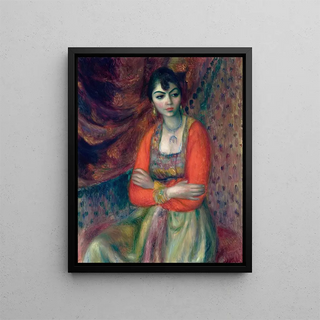Art print | Armenian girl - William James Glackens


View from behind

Frame (optional)
Art print Armenian girl - William James Glackens – Captivating introduction
In the vibrant universe of early 20th-century art, William James Glackens' "Armenian girl" stands out for its profound humanity and delicacy. This painting, which evokes a beauty that is both simple and poignant, transports us to a suspended moment, where the young girl's gaze seems to capture the viewer's soul. The soft light bathing her face and the warm tones of her clothing create an intimate atmosphere, revealing the artist's sensitivity towards his subjects. Through this work, Glackens does not merely depict a female figure; he invites us to share a moment of life, a palpable emotion that transcends time.
Style and uniqueness of the work
Glackens' style is characterized by an impressionist approach, blending vibrant color strokes with simplified forms. In "Armenian girl," this technique is manifested through bold brushstrokes that infuse dynamism into the entire composition. The palette chosen by the artist, dominated by earthy tones and shades of blue, enhances the emotional depth of the piece. Every detail, from the fabric of the clothing to the expression on the face, is treated with meticulous care that reflects Glackens' commitment to authentic representation of his subjects. This painting is not just a simple image; it becomes an open window into Armenian culture, its traditions, and its history, while paying homage to the universal beauty of youth.
The artist and his influence
William James Glackens, a prominent figure of the Ashcan School movement, captured everyday life with a unique sensitivity. His career, marked by travels across Europe, allowed him to incorporate diverse influences, ranging from realism to impressionism. Glackens was not only a talented painter but also an art critic and a passionate advocate of modern art. His work helped redefine the artistic conventions of his time, emphasizing subjects often overlooked by his contemporaries. "Armenian girl" is a perfect example, as it illustrates his

Matte finish

View from behind

Frame (optional)
Art print Armenian girl - William James Glackens – Captivating introduction
In the vibrant universe of early 20th-century art, William James Glackens' "Armenian girl" stands out for its profound humanity and delicacy. This painting, which evokes a beauty that is both simple and poignant, transports us to a suspended moment, where the young girl's gaze seems to capture the viewer's soul. The soft light bathing her face and the warm tones of her clothing create an intimate atmosphere, revealing the artist's sensitivity towards his subjects. Through this work, Glackens does not merely depict a female figure; he invites us to share a moment of life, a palpable emotion that transcends time.
Style and uniqueness of the work
Glackens' style is characterized by an impressionist approach, blending vibrant color strokes with simplified forms. In "Armenian girl," this technique is manifested through bold brushstrokes that infuse dynamism into the entire composition. The palette chosen by the artist, dominated by earthy tones and shades of blue, enhances the emotional depth of the piece. Every detail, from the fabric of the clothing to the expression on the face, is treated with meticulous care that reflects Glackens' commitment to authentic representation of his subjects. This painting is not just a simple image; it becomes an open window into Armenian culture, its traditions, and its history, while paying homage to the universal beauty of youth.
The artist and his influence
William James Glackens, a prominent figure of the Ashcan School movement, captured everyday life with a unique sensitivity. His career, marked by travels across Europe, allowed him to incorporate diverse influences, ranging from realism to impressionism. Glackens was not only a talented painter but also an art critic and a passionate advocate of modern art. His work helped redefine the artistic conventions of his time, emphasizing subjects often overlooked by his contemporaries. "Armenian girl" is a perfect example, as it illustrates his






